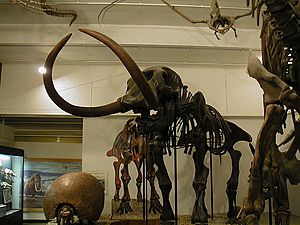Boaz mastodon and Anderson Mills mastodon facts for kids

The Boaz mastodon is the skeleton of a huge, ancient elephant-like animal. It was found near Boaz, Wisconsin, USA, in 1897. Scientists believe that early humans hunted mastodons in southwestern Wisconsin. This is because a special spear point was found near the Boaz mastodon. Today, you can see the Boaz mastodon at the University of Wisconsin Geology Museum.
Interestingly, for a long time, people thought the skeleton was complete. But in 2015, experts discovered something new. Two bones from the Boaz mastodon were mixed with many bones from another mastodon. This other mastodon is called the Anderson Mills mastodon. Together, they formed the skeleton you see today.
Contents
How the Boaz Mastodon Was Found
On July 10, 1897, a big rainstorm hit Boaz, Wisconsin. After the storm, farmer John Dosch's four sons went to check for flood damage. They were looking along Mill Creek. There, they saw some unusual bones sticking out of the creek bank. The water had washed away some of the dirt.
The boys dug out the bones. They put them on display near a hitching post by the road. The local mailman helped spread the word about their amazing discovery. Soon, stories about the bones appeared in local newspapers. These included the Republican Observer and the Richland Democrat.
The Spear Point Discovery
Near one of the ribs, the boys found something special. It was described as an arrowhead, found in the clay. This "arrowhead" was actually a fluted spear point. It suggested that humans were in the area long ago. They might have even hunted this mastodon.
The bones were later moved to the basement of the Dosch family farmhouse. Frank Burnham, a lawyer from Richland Center, Wisconsin, helped sell the bones. The State of Wisconsin bought them for fifty dollars.
Rebuilding the Giant Skeleton
The skeleton was about two-thirds complete. It was missing its tusks. In 1915, two people named M. G. Mehl and G. M. Schwartz put the skeleton back together. It was then placed in the Geology Museum of the University of Wisconsin.
Scientists estimate the Boaz mastodon was very large. It was about eighteen feet long. It stood nine and a quarter feet high. This giant animal weighed between six and eight tons.
The Mystery of the Spear Point
The spear point did not go with the bones to the University of Wisconsin at first. But in the 1940s, the University received an envelope. Inside was a quartzite spear point. The envelope had a return address from D. C. L. Dosch in Maysville, Missouri. Someone had scribbled on it: "allegedly found with U.W. elephant."
In 1962, the two Dosch brothers who were still alive confirmed it. They said the spear point looked like the one they found 66 years earlier. This special spear point is made of quartzite. This type of rock comes from the Silver Mound Archeological District. That area is about 80 miles north of Boaz.
How Old Are the Skeletons?
Scientists use a method called radiocarbon dating to find out how old ancient things are. They used this method on bones from both mastodon skeletons.
The Anderson Mills mastodon bones were found to be about 12,910 years old. The Boaz mastodon is one of the most recently found mastodons. Its bones are about 12,220 years old. This shows how long ago these amazing creatures lived!

